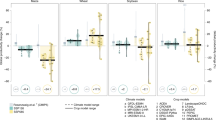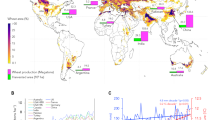Abstract
We assess the benefits of climate change mitigation for global maize and wheat production over the 21st century by comparing outcomes under RCP4.5 and RCP8.5 as simulated by two large initial condition ensembles from NCAR’s Community Earth System Model. We use models of the relation between climate variables, CO2 concentrations, and yields built on observations and then project this relation on the basis of simulated future temperature and precipitation and CO2 trajectories under the two scenarios, for short (2021–2040), medium (2041–2060) and long (2061–2080) time horizons. We focus on projected mean yield impacts, chances of significant slowdowns in yield, and exposure to damaging heat during critical periods of the growing seasons, the last of which is not explicitly considered in yield impacts by most models, including ours. We find that substantial benefits from mitigation would be achieved throughout the 21st century for maize, in terms of reducing (1) the size of average yield impacts, with mean losses for maize under RCP8.5 reduced under RCP4.5 by about 25 %, 40 % and 50 % as the time horizon lengthens over the 21st century; (2) the risk of major slowdowns over a 10 or 20 year period, with maize chances under RCP4.5 being reduced up to ~75 % by the end of the century compared to those estimated under RCP8.5; and (3) exposure to critical or “lethal” heat extremes, with the number of extremely hot days under RCP8.5 roughly triple current levels by end of century, compared to a doubling for RCP4.5. For wheat, we project small or occasionally negative effects of mitigation for projected yields, because of stronger CO2 fertilization effects than in maize, but substantial benefits of mitigation remain in terms of exposure to extremely high temperatures.




Similar content being viewed by others
References
Amthor JS (2003) Effects of atmospheric CO2 concentration on wheat yield : review of results from experiments using various approaches to control CO2 concentration. Field Crop Res 84(3):395–396
Asseng S et al. (2013) Uncertainty in simulating wheat yields under climate change. Nat Clim Chang 3:827–832
Asseng S et al. (2015) Rising temperatures reduce global wheat production. Nat Clim Chang 5(2):143–147
Bassu S et al. (2014) How do various maize crop models vary in their responses to climate change factors? Glob Chang Biol 20:2301–2320
Deryng D et al. (2014) Global crop yield response to extreme heat stress under multiple climate change futures. Environ Res Lett 9:034011
FAO (2013) FAO Statistical Databases (Rome: FAO). http://faostat.fao.org/site/291/default.aspx
Fischer RA, Byerlee D, Edmeades GO (2014) Crop yields and global food security: will yield increase continue to feed the world? Canberra: Australian Centre for international agricultural research. http://aciar.gov.au/publication/mn158
Gourdji SM, Mathews KL, Reynolds M, Crossa J, Lobell DB (2013a) An assessment of wheat yield sensitivity and breeding gains in hot environments. Proc R Soc B Biol Sci 280:20122190
Gourdji SM, Sibley AM, Lobell DB (2013b) Global crop exposure to critical high temperatures in the reproductive period: historical trends and future projections. Environ Res Lett 8:024041
Hatfield JL et al. (2011) Climate impacts on agriculture: implications for crop production. Agron J 103(2):351–370
Hurrell JW et al. (2013) The community earth system model: a framework for collaborative research. Bull Am Meteorol Soc 94:1339–1360
Jones JW et al. (2003) The DSSAT cropping system model. Eur J Agron 18(3–4):235–265
Kay J et al. (2014) The community earth system model (CESM) large ensemble project: a community resource for studying climate change in the presence of internal climate variability. Bull Am Meteorol Soc. doi:10.1175/BAMS-D-13-00255.1
Leakey ADB et al. (2009) Elevated CO2 effects on plant carbon, nitrogen, and water relations: six important lessons from FACE. J Exp Bot 60(10):2859–2876
Leff B, Ramankutty N, Foley JA (2004) Geographic distribution of major crops across the world. Glob Biogeochem Cycles. 18(1). doi:10.1029/2003GB002108
Lobell DB, Field CB (2007) Global scale climate-crop yield relationships and the impacts of recent warming. Environ Res Lett 2:004000–004007
Lobell DB, Tebaldi C (2014) Getting caught with our plants down: the risks of a crop yield slowdown from climate trends in next two decades. Environ Res Lett 9:074003–074008
Lobell DB, Schlenker W, Costa-Roberts J (2011) Climate trends and global crop production since 1980. Science 333:616–620
Long SP et al. (2006) Food for thought: lower-than-expected crop yield stimulation with rising CO2 concentrations. Science 312(5782):1918–1921
Matsui T et al. (1997) Effects of high temperature and CO2 concentration on spikelet sterility in indica rice. Field Crop Res 51(3):213–219
McGinnis S, Nychka D, Mearns LO (2015) A new distribution mapping technique for climate model bias correction. In: Lakshmanan V, Gilleland E, McGovern A, Tingley M (eds.) Machine learning and data mining approaches to climate science: proceedings of the fourth international workshop on climate informatics, Springer. doi:10.1007/978-3-319-17220-0_1
Morice CP et al. (2012) Quantifying uncertainties in global and regional temperature change using an ensemble of observational estimates: the HadCRUT4 dataset. J Geophys Res 117:D08101. doi:10.1029/2011JD017187
Rosenzweig C et al. (2014) Assessing agricultural risks of climate change in the 21st century in a global gridded crop model intercomparison. Proc Natl Acad Sci U S A 111(9):3268–3273
Sacks WJ, Deryng D, Foley JA, Ramankutty N (2010) Crop planting dates: an analysis of global patterns. Glob Ecol Biogeogr 19(5):607–20
Sánchez B, Rasmussen A, Porter JR (2014) Temperatures and the growth and development of maize and rice: a review. Glob Chang Biol 20:408–417
Schlenker W, Roberts MJ (2009) Nonlinear temperature effects indicate severe damages to US crop yields under climate change. Proc Natl Acad Sci U S A 106(37):15594–15598
Schmitz C et al. (2014) Land-use change trajectories up to 2050: insights from a global agro-economic model comparison. Agric Econ 45:69–84
Siebert S et al. (2014) Impact of heat stress on crop yield-on the importance of considering canopy temperature. Environ Res Lett 9(4):044012
SREX (2012) Field CB, Barros V, Stocker TF, et al. (eds) Managing the risks of extreme events and disasters to advance climate change adaptation. a special report of working groups I and II of the IPCC. Cambridge University Press, Cambridge
Tebaldi C, Lobell DB (2008) Towards probabilistic projections of climate change impacts on global crop yields. Geophys Res Lett 35:L08705. doi:10.1029/2008GL033423
Tebaldi C, Friedlingstein P (2013) Delayed detection of climate mitigation benefits due to climate inertia and variability. Proc Natl Acad Sci U S A 110(43):17229–17234
Teixeira EI et al. (2013) Global hot-spots of heat stress on agricultural crops due to climate change. Agric For Meteorol 170(SI):206–215
Tubiello FN, Fischer G (2007) Reducing climate change impacts on agriculture:global and regional effects of mitigation, 2000–2080. Technol Forecast Soc Chang 74:1030–1056
VanVuuren DP et al. (2011) Representative concentration pathways: an overview. Clim Chang 109(1–2):5–31
Acknowledgments
C. T. was supported by the Regional and Global Climate Modeling Program (RGCM) of the U.S. Department of Energy, Office of Science (BER), Cooperative Agreement DE-FC02-97ER62402.
Author information
Authors and Affiliations
Corresponding author
Additional information
This article is part of a Special Issue on “Benefits of Reduced Anthropogenic Climate ChangE (BRACE)” edited by Brian O’Neill and Andrew Gettelman.
Electronic supplementary material
ESM 1
(DOCX 8.65 mb)
Rights and permissions
About this article
Cite this article
Tebaldi, C., Lobell, D. Estimated impacts of emission reductions on wheat and maize crops. Climatic Change 146, 533–545 (2018). https://doi.org/10.1007/s10584-015-1537-5
Received:
Accepted:
Published:
Issue Date:
DOI: https://doi.org/10.1007/s10584-015-1537-5




